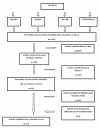Neuromuscular training to enhance sensorimotor and functional deficits in subjects with chronic ankle instability: A systematic review and best evidence synthesis
- PMID: 21939557
- PMCID: PMC3189141
- DOI: 10.1186/1758-2555-3-19
Neuromuscular training to enhance sensorimotor and functional deficits in subjects with chronic ankle instability: A systematic review and best evidence synthesis
Abstract
Objective: To summarise the available evidence for the efficacy of neuromuscular training in enhancing sensorimotor and functional deficits in subjects with chronic ankle instability (CAI).
Design: Systematic review with best evidence synthesis.
Data sources: An electronic search was conducted through December 2009, limited to studies published in the English language, using the Pubmed, CINAHL, Embase, and SPORTDiscus databases. Reference screening of all included articles was also undertaken.
Methods: Studies were selected if the design was a RCT, quasi RCT, or a CCT; the patients were adolescents or adults with confirmed CAI; and one of the treatment options consisted of a neuromuscular training programme. The primary investigator independently assessed the risk of study bias and extracted relevant data. Due to clinical heterogeneity, data was analysed using a best-evidence synthesis.
Results: Fourteen studies were included in the review. Meta-analysis with statistical pooling of data was not possible, as the studies were considered too heterogeneous. Instead a best evidence synthesis was undertaken. There is limited to moderate evidence to support improvements in dynamic postural stability, and patient perceived functional stability through neuromuscular training in subjects with CAI. There is limited evidence of effectiveness for neuromuscular training for improving static postural stability, active and passive joint position sense (JPS), isometric strength, muscle onset latencies, shank/rearfoot coupling, and a reduction in injury recurrence rates. There is limited evidence of no effectiveness for improvements in muscle fatigue following neuromuscular intervention.
Conclusion: There is limited to moderate evidence of effectiveness in favour of neuromuscular training for various measures of static and dynamic postural stability, active and passive JPS, isometric strength, muscle onset latencies, shank/rearfoot coupling and injury recurrence rates. Strong evidence of effectiveness was lacking for all outcome measures. All but one of the studies included in the review were deemed to have a high risk of bias, and most studies were lacking sufficient power. Therefore, in future we recommend conducting higher quality RCTs using appropriate outcomes to assess for the effectiveness of neuromuscular training in overcoming sensorimotor deficits in subjects with CAI.
Figures
References
LinkOut - more resources
Full Text Sources
Medical



